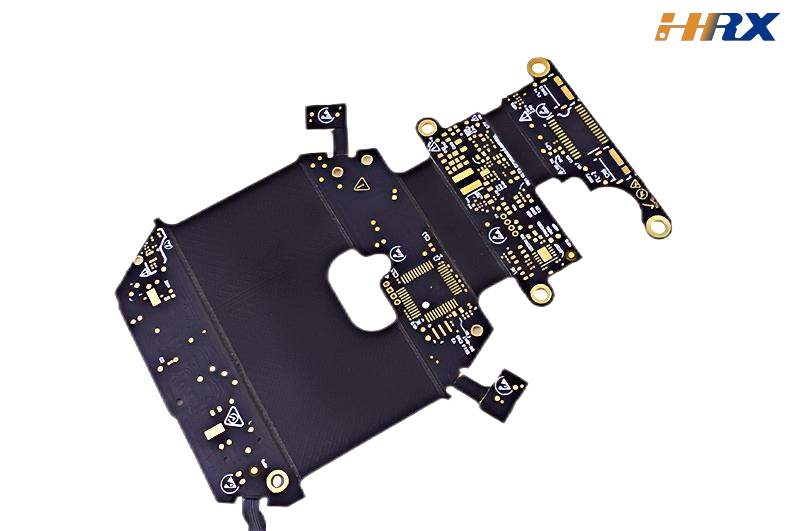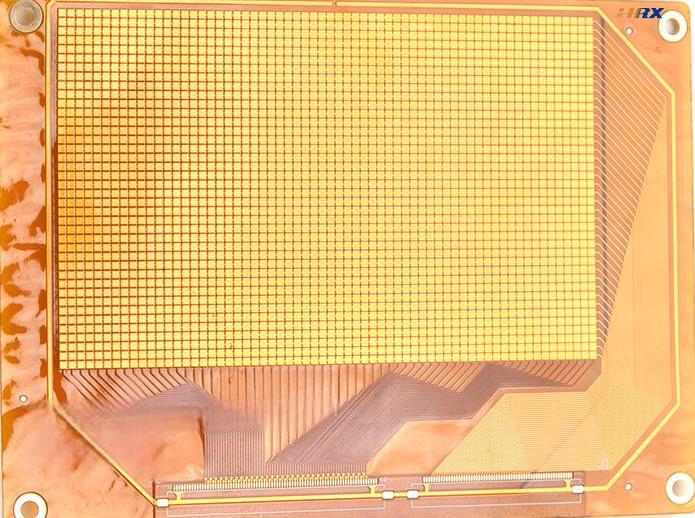Introduction: The Critical Role of FPCs in 5G RF Systems
In the 5G era, Flexible Printed Circuits (FPCs) serve as the critical interconnection layer for high-frequency (HF) signal transmission (10GHz–100GHz) in applications ranging from smartphones to automotive telematics. At Huaruixin Electronics, we specialize in designing FPCs with ±5% impedance tolerance (vs. industry standard ±10%) and advanced EMI/RFI shielding—essential for 5G NR compliance (3GPP TS 38.104) and mmWave (24GHz–100GHz) performance.

Section 1: 5G FPC Design Fundamentals: Impedance Control Architecture
Signal Integrity (SI) Engineering
Impedance Matching: Mismatched characteristic impedance (Z₀) causes signal reflections (return loss RL > -10dB), degrading SNR and data rates (5G NR requires ≥10Gbps throughput).
Power Integrity (PI): High-power 5G modules (2–5W/cm²) demand low-loss power delivery (IR drop <50mV).
Stepped Impedance Topology
Our proprietary three-stage impedance matching network optimizes signal transition:
1.Antenna Interface (Z₁ = 50Ω ±5%): Optimized for mmWave antenna arrays (IEC 62607-3-1 compliant).
2.Transmission Line (Z₂ = 75Ω ±3%): Low-loss dielectric (Dk 2.9–3.1, Df <0.002@10GHz).
3.System Interface (Z₃ = 50Ω ±5%): Matches RF front-end (RFFE) impedance (e.g., 5G modems).
Section 2: EMI/RFI Mitigation: Layered Shielding Architecture
HF Noise Challenges
5G systems generate broadband noise (2GHz–20GHz), requiring shielding effectiveness (SE) >60dB@10GHz (IEC 61000-4-3).
Proprietary Shielding Solution
Our multi-layer shielding architecture (US Patent pending):
Layer 1: Conductive adhesive (3M™ 9713) for ground plane termination.
Layer 2: Nano-composite shielding layer (Ni-Cu alloy, 5–8μm thickness).
Layer 3: Dielectric spacer (Dk 2.5±0.1) to prevent capacitive coupling.
Performance Metrics
Frequency (GHz) | Insertion Loss (IL) | Return Loss (RL) | Shielding Effectiveness (SE) |
10 | <0.5dB | >-15dB | >65dB |
28 (mmWave) | <0.8dB | >-12dB | >55dB |
Validation: Keysight PNA-X N5247A (2-port S-parameter testing, 10MHz–110GHz).
Section 3: Huaruixin’s Core FPC Technologies
1. Nano-Surface Engineering™
Process: Plasma etching + atomic layer deposition (ALD) of Al₂O₃ (20nm thickness).
Benefits:
Reduced conductor roughness (Ra <0.3μm) → lower skin effect loss (20% improvement).
Enhanced solder joint reliability (IPC-A-610 Class 3 compliant).
2. Anisotropic Conductive Film (ACF) Integration
Application: High-density FPC-to-PCB interconnects (pitch ≤10μm).
Advantage: 30% size reduction vs. traditional SMT (IPC-9850 compliant).
3. Thermal-Electromagnetic Co-Simulation
Tools: ANSYS HFSS (EMI) + Icepak (thermal).
Optimization:
Copper thickness (18–70μm) for thermal dissipation (θJA <15℃/W).
Via-in-pad (VIP) design for via inductance reduction (<0.5nH).
Section 4: 5G FPC Performance Benchmark
Parameter | Industry Standard | Huaruixin’s Performance |
Impedance Tolerance | ±10% | ±5% (mmWave certified) |
Bending Endurance | 100k cycles (IPC-2223) | 200k cycles (CPI film option) |
Dielectric Loss (Df@10GHz) | 0.003–0.004 | 0.0018–0.0022 (LCP/MPI hybrid) |
Thermal Resistance | 1.2–1.5℃·cm/W | 0.7–0.9℃·cm/W (copper-integrated) |
Prototyping Lead Time | 10–14 days | 5–7 days (Shenzhen-based rapid prototyping) |
Section 5: Next-Gen FPC Innovations
1.6G Pre-Engineering:
Sub-THz FPCs (100–300GHz) with liquid crystal polymer (LCP) substrates (Dk 2.8±0.05).
Embedded passive components (EPCs): 0402-size inductors/capacitors (Q-factor >50@20GHz).
2.AI-Driven Diagnostics:
Embedded sensor networks (TI AFE4403-based) for real-time impedance monitoring (±2% accuracy).
3.Sustainable Manufacturing:
“GreenFPC” initiative: 95% material recyclability (IEC 62619 compliant).
Partner with Huaruixin for 5G Success
Why Choose Us?
✅ Engineering Excellence: 20+ years in FPC R&D (150+ patents, 5G/mmWave specialty).
✅ Vertical Integration: In-house capabilities—from material science (PI/LCP) to final assembly.
✅ China Shenzhen’s Mature Supply Chain: 1-hour access to tier-1 suppliers (materials, testing, prototyping) via Shenzhen’s integrated electronics ecosystem (ISO -certified).

 Huaruixin Electronics mainly produces printed circuit boards as the core business, to provide customers with one-stop solutions for FPC/PCB production, components sourcing and Assembly.
Huaruixin Electronics mainly produces printed circuit boards as the core business, to provide customers with one-stop solutions for FPC/PCB production, components sourcing and Assembly.


